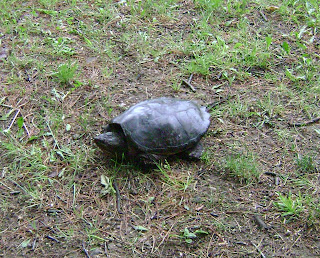 Here's a little more information about the Common Snapping Turtle:
Here's a little more information about the Common Snapping Turtle:Common habitats are shallow ponds, shallow lakes, or streams. Common Snapping Turtles sometimes bask -- though rarely observed -- by floating on the surface with only their carapace exposed, though in the northern parts of their range they will also readily bask on fallen logs in early spring. In shallow waters, Common snappers may lie beneath a muddy bottom with only the head exposed, stretching their long necks to the surface for an occasional breath (note that their nostrils are positioned on the very tip of the snout, effectively functioning as snorkels). Snapping turtles are omnivores, consuming both plant and animal matter, and are important aquatic scavengers; but they are also active hunters that prey on anything they can swallow, including many invertebrates, fish, frogs, reptiles (including snakes and smaller turtles), unwary birds and small mammals. Snappers will travel extensively overland to reach new habitat or to lay eggs. Pollution, habitat destruction, food scarcity, overcrowding and other factors will drive snappers to move overland; it is quite common to find them traveling far from the nearest water source. This species mates from April through November, with their peak laying season in June and July. Females travel over land to find sandy soil in which to lay their eggs, often some distance from the water. After digging a hole, the female typically deposits 25 to 80 eggs each year, guiding them into the nest with her hind feet and covering them with sand for incubation and protection.
Wow, thank you Wikipedia!!



No comments:
Post a Comment